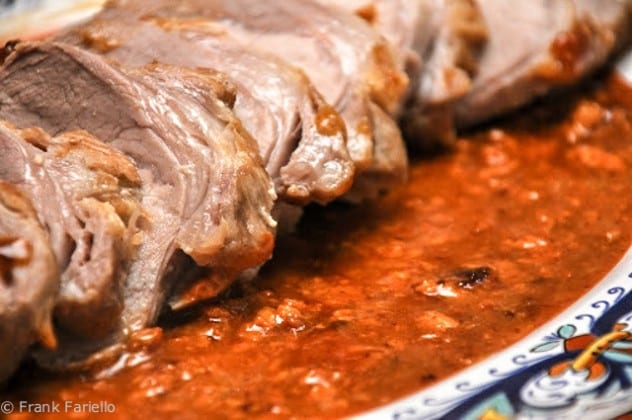Ingredients
- – One pork roast (see Notes)
- – Salt and pepper
- – A good nub of butter, plus a small drizzle of olive oil
- – 1-2 cloves of garlic, slightly crushed
- – A sprig of fresh rosemary
- – Milk, q.b.
- – Optional: A good pour of heavy cream
Directions
- Season the pork roast with salt and pepper, then brown it in butter (or butter mixed with a bit of oil to retard burning) along with the garlic and rosemary in a Dutch oven or casserole in which the roast fits snugly. (Remove the garlic as soon as it begins to brown.)
- Pour enough milk to come halfway up the roast, cover and allow to simmer slowly under the lowest possible heat until the pork is done and the milk has reduced and separated into dark brown curds and fat. If the pork is done before the milk has reduced—which is likely if you are using a pork loin or tenderloin—then remove it and keep it warm while the milk continues to simmer, then return the roast to the casserole to reheat when the sauce is ready.
- If you are having a family-style meal, you’re done. Just slice the roast, nap with the sauce and serve. It will not be particularly pretty but it will be very tasty. If you want a more elegant effect, then you can do one or both of two things: add some heavy cream to the milk, which will cause the sauce to amalgamate, and continue simmering until the sauce is dark and smooth (see photo). You can also blend the sauce (with or without the additional of cream) to a smooth and perfectly even consistency.
Notes
The dish is simplicity itself, but there is one point you need to watch out for: the old recipes called for braising an arista (pork loin) for a couple of hours, enough time to allow the meat to become fork-tender and the milk to reduce completely. But these days pork (at least in the US) is bred for leanness, which means that cooking a loin for that long is likely to result in dry, overcooked meat. So try to find a pork loin with as much fat on it as you can, then carefully gauge the internal temperature after the first 30-45 minutes until you reach 65°C/150°F, at which point you can remove the roast from the casserole and let it rest while the sauce continues to simmer. The meat will continue to cook as it rests. (NB: The USDA recommends cooking to 70°C/160°F for health reasons, particularly pregnant women, children, the elderly and those with decreased immune function.)




